check engine Lancia Voyager 2014 Owner handbook (in English)
[x] Cancel search | Manufacturer: LANCIA, Model Year: 2014, Model line: Voyager, Model: Lancia Voyager 2014Pages: 364, PDF Size: 3.49 MB
Page 192 of 364
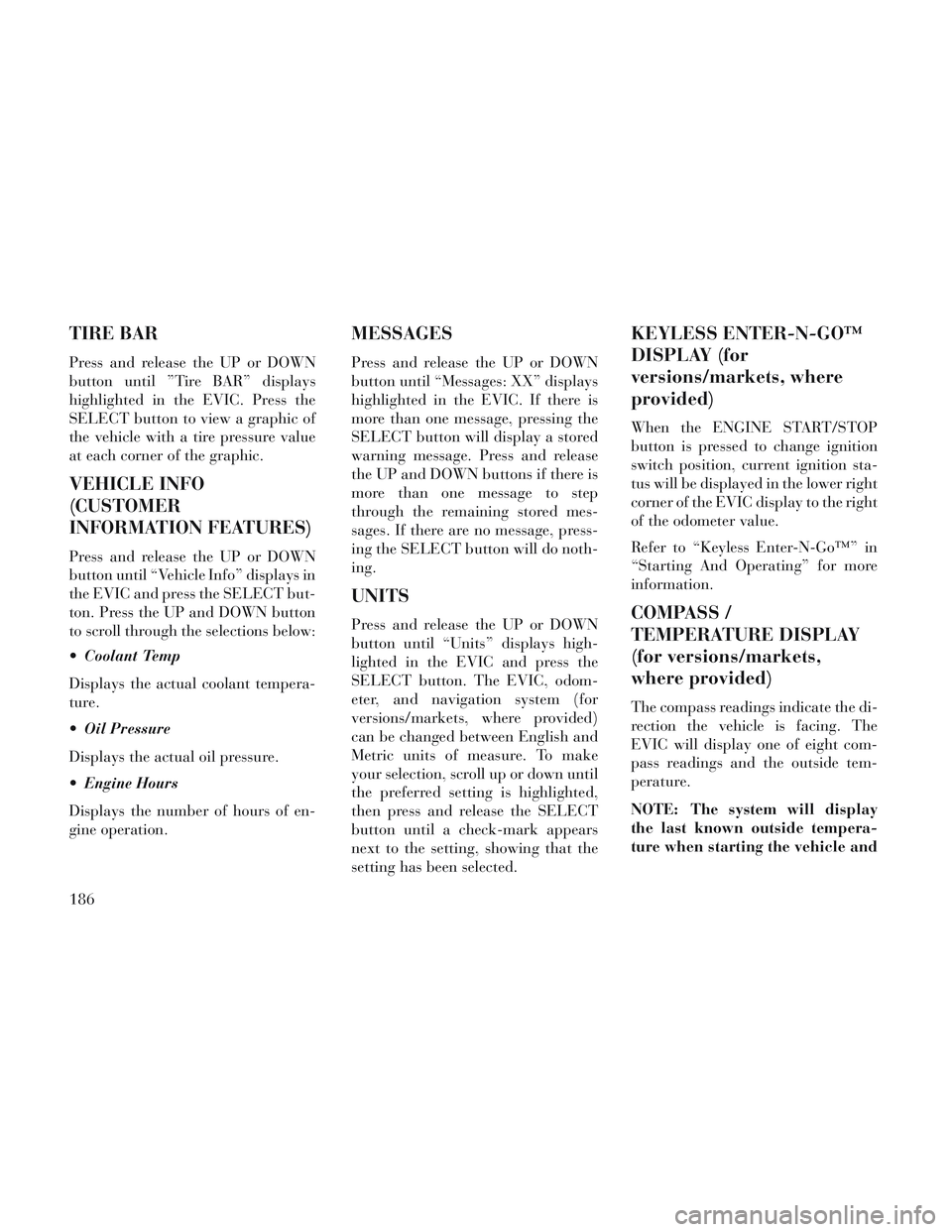
TIRE BAR
Press and release the UP or DOWN
button until ”Tire BAR” displays
highlighted in the EVIC. Press the
SELECT button to view a graphic of
the vehicle with a tire pressure value
at each corner of the graphic.
VEHICLE INFO
(CUSTOMER
INFORMATION FEATURES)
Press and release the UP or DOWN
button until “Vehicle Info” displays in
the EVIC and press the SELECT but-
ton. Press the UP and DOWN button
to scroll through the selections below:
Coolant Temp
Displays the actual coolant tempera-
ture.
Oil Pressure
Displays the actual oil pressure.
Engine Hours
Displays the number of hours of en-
gine operation.
MESSAGES
Press and release the UP or DOWN
button until “Messages: XX” displays
highlighted in the EVIC. If there is
more than one message, pressing the
SELECT button will display a stored
warning message. Press and release
the UP and DOWN buttons if there is
more than one message to step
through the remaining stored mes-
sages. If there are no message, press-
ing the SELECT button will do noth-
ing.
UNITS
Press and release the UP or DOWN
button until “Units” displays high-
lighted in the EVIC and press the
SELECT button. The EVIC, odom-
eter, and navigation system (for
versions/markets, where provided)
can be changed between English and
Metric units of measure. To make
your selection, scroll up or down until
the preferred setting is highlighted,
then press and release the SELECT
button until a check-mark appears
next to the setting, showing that the
setting has been selected.
KEYLESS ENTER-N-GO™
DISPLAY (for
versions/markets, where
provided)
When the ENGINE START/STOP
button is pressed to change ignition
switch position, current ignition sta-
tus will be displayed in the lower right
corner of the EVIC display to the right
of the odometer value.
Refer to “Keyless Enter-N-Go™” in
“Starting And Operating” for more
information.
COMPASS /
TEMPERATURE DISPLAY
(for versions/markets,
where provided)
The compass readings indicate the di-
rection the vehicle is facing. The
EVIC will display one of eight com-
pass readings and the outside tem-
perature.
NOTE: The system will display
the last known outside tempera-
ture when starting the vehicle and
186
Page 233 of 364
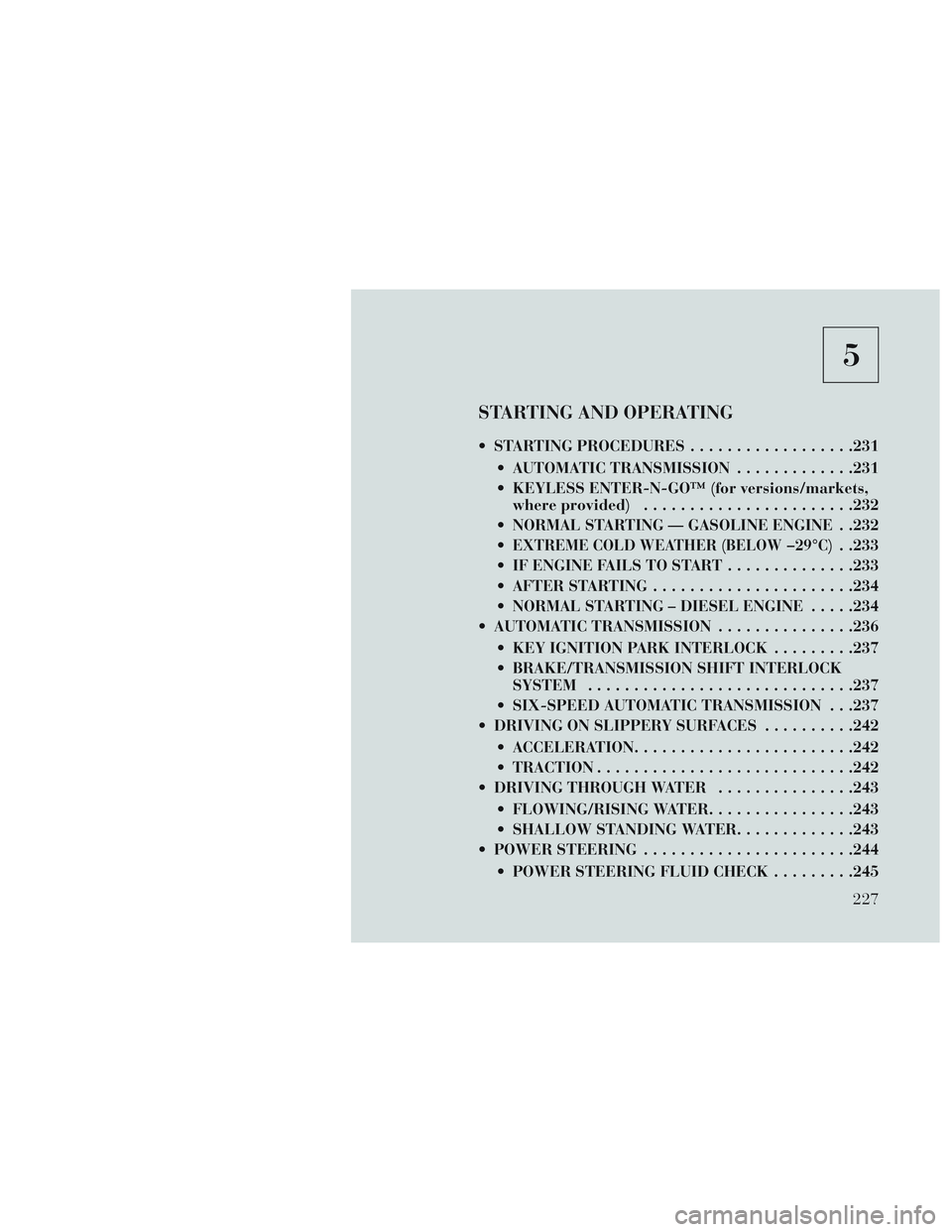
5
STARTING AND OPERATING
STARTING PROCEDURES..................231
AUTOMATIC TRANSMISSION .............231
KEYLESS ENTER-N-GO™ (for versions/markets, where provided) ...................... .232
NORMAL STARTING — GASOLINE ENGINE . .232
EXTREME COLD WEATHER (BELOW �29°C). .233
IF ENGINE FAILS TO START ..............233
AFTER STARTING ..................... .234
NORMAL STARTING – DIESEL ENGINE .....234
AUTOMATIC TRANSMISSION ...............236
KEY IGNITION PARK INTERLOCK .........237
BRAKE/TRANSMISSION SHIFT INTERLOCK SYSTEM ............................ .237
SIX-SPEED AUTOMATIC TRANSMISSION . . .237
DRIVING ON SLIPPERY SURFACES ..........242
ACCELERATION ....................... .242
TRACTION ........................... .242
DRIVING THROUGH WATER ...............243
FLOWING/RISING WATER ................243
SHALLOW STANDING WATER .............243
POWER STEERING ...................... .244
POWER STEERING FLUID CHECK .........245
227
Page 244 of 364

GEAR RANGES
DO NOT race the engine when shift-
ing from PARK or NEUTRAL into
another gear range.
NOTE: After selecting any gear
range, wait a moment to allow the
selected gear to engage before ac-
celerating. This is especially im-
portant when the engine is cold.
PARK (P)
This range supplements the parking
brake by locking the transmission.
The engine can be started in this
range. Never attempt to use PARK
while the vehicle is in motion. Apply
the parking brake when leaving the
vehicle in this range.
When parking on a level surface, you
may shift the transmission into PARK
first, and then apply the parking
brake.
When parking on a hill, apply the
parking brake before shifting the
transmission to PARK, otherwise the
load on the transmission locking
mechanism may make it difficult to
move the shift lever out of PARK. Asan added precaution, turn the front
wheels toward the curb on a downhill
grade, and away from the curb on an
uphill grade.
WARNING!
Never use the PARK position as a
substitute for the parking brake.
Always apply the parking brake
fully when parked to guard
against vehicle movement and
possible injury or damage.
Your vehicle could move and in- jure you and others if it is not
completely in PARK. Check by
trying to move the shift lever out
of PARK with the brake pedal
released. Make sure the transmis-
sion is in PARK before leaving the
vehicle.
(Continued)
WARNING!(Continued)
It is dangerous to shift out ofPARK or NEUTRAL if the engine
speed is higher than idle speed. If
your foot is not firmly pressing
the brake pedal, the vehicle could
accelerate quickly forward or in
reverse. You could lose control of
the vehicle and hit someone or
something. Only shift into gear
when the engine is idling nor-
mally and your foot is firmly
pressing the brake pedal.
Unintended movement of a ve- hicle could injure those in or near
the vehicle. As with all vehicles,
you should never exit a vehicle
while the engine is running. Be-
fore exiting a vehicle, always ap-
ply the parking brake, shift the
transmission into PARK, turn the
engine OFF, and remove the key
fob. When the ignition is in the
LOCK position, the transmission
is locked in PARK, securing the
vehicle against unwanted move-
ment.
(Continued)
238
Page 251 of 364
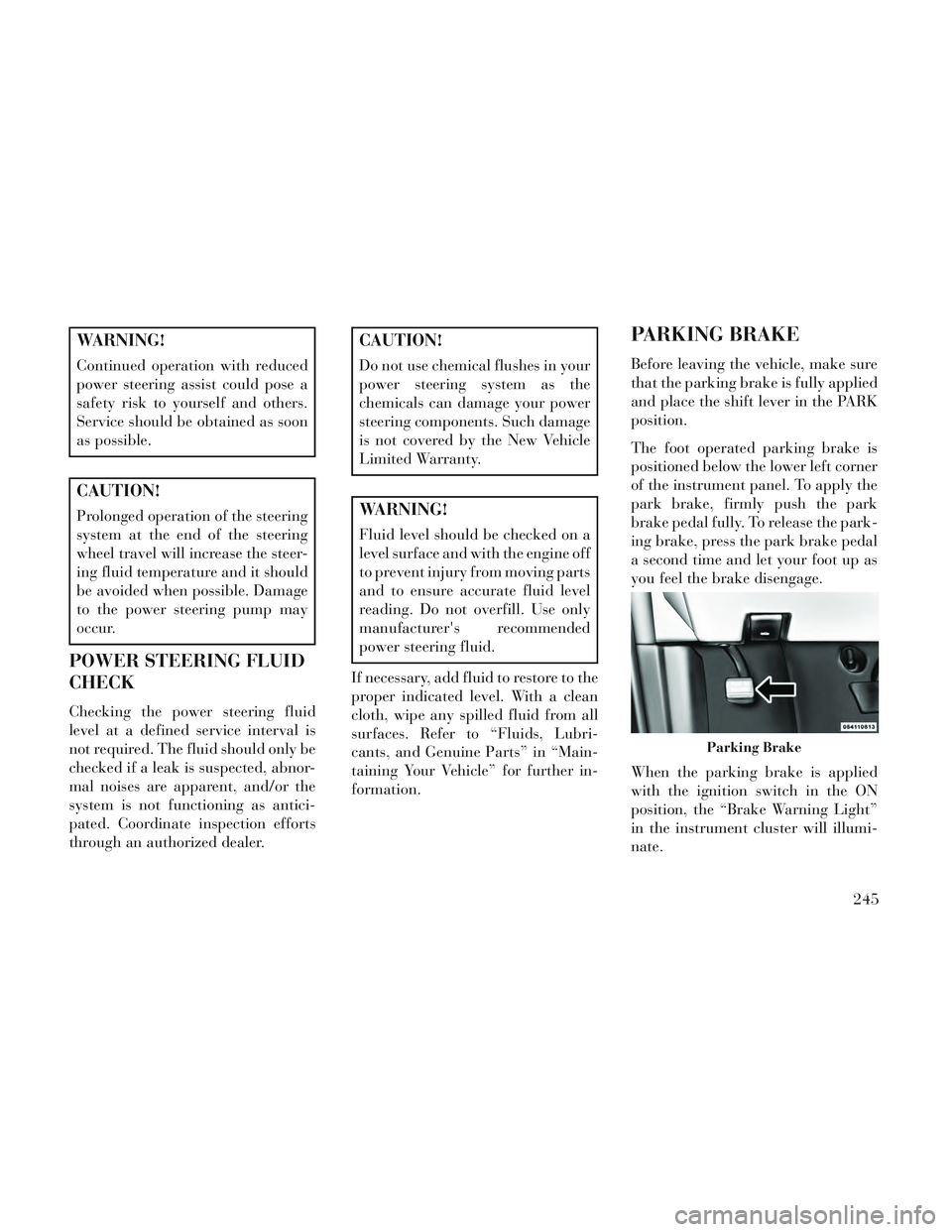
WARNING!
Continued operation with reduced
power steering assist could pose a
safety risk to yourself and others.
Service should be obtained as soon
as possible.
CAUTION!
Prolonged operation of the steering
system at the end of the steering
wheel travel will increase the steer-
ing fluid temperature and it should
be avoided when possible. Damage
to the power steering pump may
occur.
POWER STEERING FLUID
CHECK
Checking the power steering fluid
level at a defined service interval is
not required. The fluid should only be
checked if a leak is suspected, abnor-
mal noises are apparent, and/or the
system is not functioning as antici-
pated. Coordinate inspection efforts
through an authorized dealer.
CAUTION!
Do not use chemical flushes in your
power steering system as the
chemicals can damage your power
steering components. Such damage
is not covered by the New Vehicle
Limited Warranty.
WARNING!
Fluid level should be checked on a
level surface and with the engine off
to prevent injury from moving parts
and to ensure accurate fluid level
reading. Do not overfill. Use only
manufacturer's recommended
power steering fluid.
If necessary, add fluid to restore to the
proper indicated level. With a clean
cloth, wipe any spilled fluid from all
surfaces. Refer to “Fluids, Lubri-
cants, and Genuine Parts” in “Main-
taining Your Vehicle” for further in-
formation.
PARKING BRAKE
Before leaving the vehicle, make sure
that the parking brake is fully applied
and place the shift lever in the PARK
position.
The foot operated parking brake is
positioned below the lower left corner
of the instrument panel. To apply the
park brake, firmly push the park
brake pedal fully. To release the park-
ing brake, press the park brake pedal
a second time and let your foot up as
you feel the brake disengage.
When the parking brake is applied
with the ignition switch in the ON
position, the “Brake Warning Light”
in the instrument cluster will illumi-
nate.
Parking Brake
245
Page 302 of 364

WARNING!
To avoid the risk of forcing the ve-
hicle off the jack, do not tighten the
wheel nuts fully until the vehicle
has been lowered. Failure to follow
this warning may result in personal
injury.
3. Lower the vehicle to the ground by
turning the jack handle counterclock-
wise.
4. Refer to “Torque Specifications”
in this section for correct lug nut
torque.
5. After 40 km check the lug nut
torque with a torque wrench to ensure
that all lug nuts are properly seated
against the wheel.
JUMP-STARTING
If your vehicle has a discharged bat-
tery it can be jump-started using a set
of jumper cables and a battery in an-
other vehicle or by using a portable
battery booster pack. Jump-starting
can be dangerous if done improperly
so please follow the procedures in this
section carefully. NOTE: When using a portable
battery booster pack follow the
manufacturer’s operating instruc-
tions and precautions.
CAUTION!
Do not use a portable battery
booster pack or any other booster
source with a system voltage
greater than 12 Volts or damage to
the battery, starter motor, alterna-
tor or electrical system may occur.
WARNING!
Do not attempt jump-starting if the
battery is frozen. It could rupture or
explode and cause personal injury.
PREPARATIONS FOR
JUMP-START
The battery in your vehicle is located
on the left side of the engine compart-
ment.
WARNING!
Take care to avoid the radiator
cooling fan whenever the hood is
raised. It can start anytime the
ignition switch is ON. You can be
injured by moving fan blades.
Remove any metal jewelry such as rings, watch bands and brace-
lets that could make an inadver-
tent electrical contact. You could
be seriously injured.
Batteries contain sulfuric acid that can burn your skin or eyes
and generate hydrogen gas which
is flammable and explosive. Keep
open flames or sparks away from
the battery.
Positive Battery Post
296
Page 314 of 364
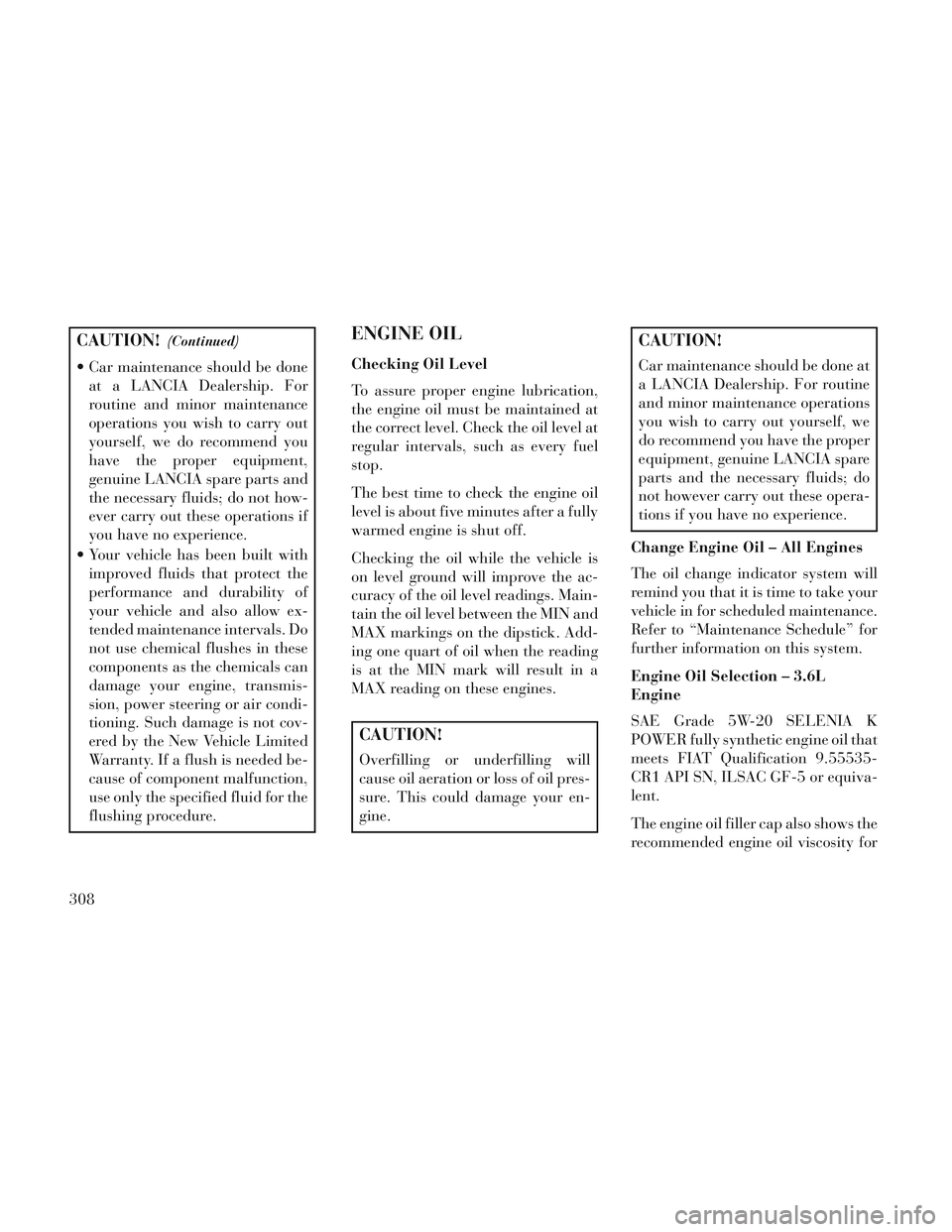
CAUTION!(Continued)
Car maintenance should be doneat a LANCIA Dealership. For
routine and minor maintenance
operations you wish to carry out
yourself, we do recommend you
have the proper equipment,
genuine LANCIA spare parts and
the necessary fluids; do not how-
ever carry out these operations if
you have no experience.
Your vehicle has been built with improved fluids that protect the
performance and durability of
your vehicle and also allow ex-
tended maintenance intervals. Do
not use chemical flushes in these
components as the chemicals can
damage your engine, transmis-
sion, power steering or air condi-
tioning. Such damage is not cov-
ered by the New Vehicle Limited
Warranty. If a flush is needed be-
cause of component malfunction,
use only the specified fluid for the
flushing procedure.
ENGINE OIL
Checking Oil Level
To assure proper engine lubrication,
the engine oil must be maintained at
the correct level. Check the oil level at
regular intervals, such as every fuel
stop.
The best time to check the engine oil
level is about five minutes after a fully
warmed engine is shut off.
Checking the oil while the vehicle is
on level ground will improve the ac-
curacy of the oil level readings. Main-
tain the oil level between the MIN and
MAX markings on the dipstick. Add-
ing one quart of oil when the reading
is at the MIN mark will result in a
MAX reading on these engines.
CAUTION!
Overfilling or underfilling will
cause oil aeration or loss of oil pres-
sure. This could damage your en-
gine.
CAUTION!
Car maintenance should be done at
a LANCIA Dealership. For routine
and minor maintenance operations
you wish to carry out yourself, we
do recommend you have the proper
equipment, genuine LANCIA spare
parts and the necessary fluids; do
not however carry out these opera-
tions if you have no experience.
Change Engine Oil – All Engines
The oil change indicator system will
remind you that it is time to take your
vehicle in for scheduled maintenance.
Refer to “Maintenance Schedule” for
further information on this system.
Engine Oil Selection – 3.6L
Engine
SAE Grade 5W-20 SELENIA K
POWER fully synthetic engine oil that
meets FIAT Qualification 9.55535-
CR1 API SN, ILSAC GF-5 or equiva-
lent.
The engine oil filler cap also shows the
recommended engine oil viscosity for
308
Page 321 of 364
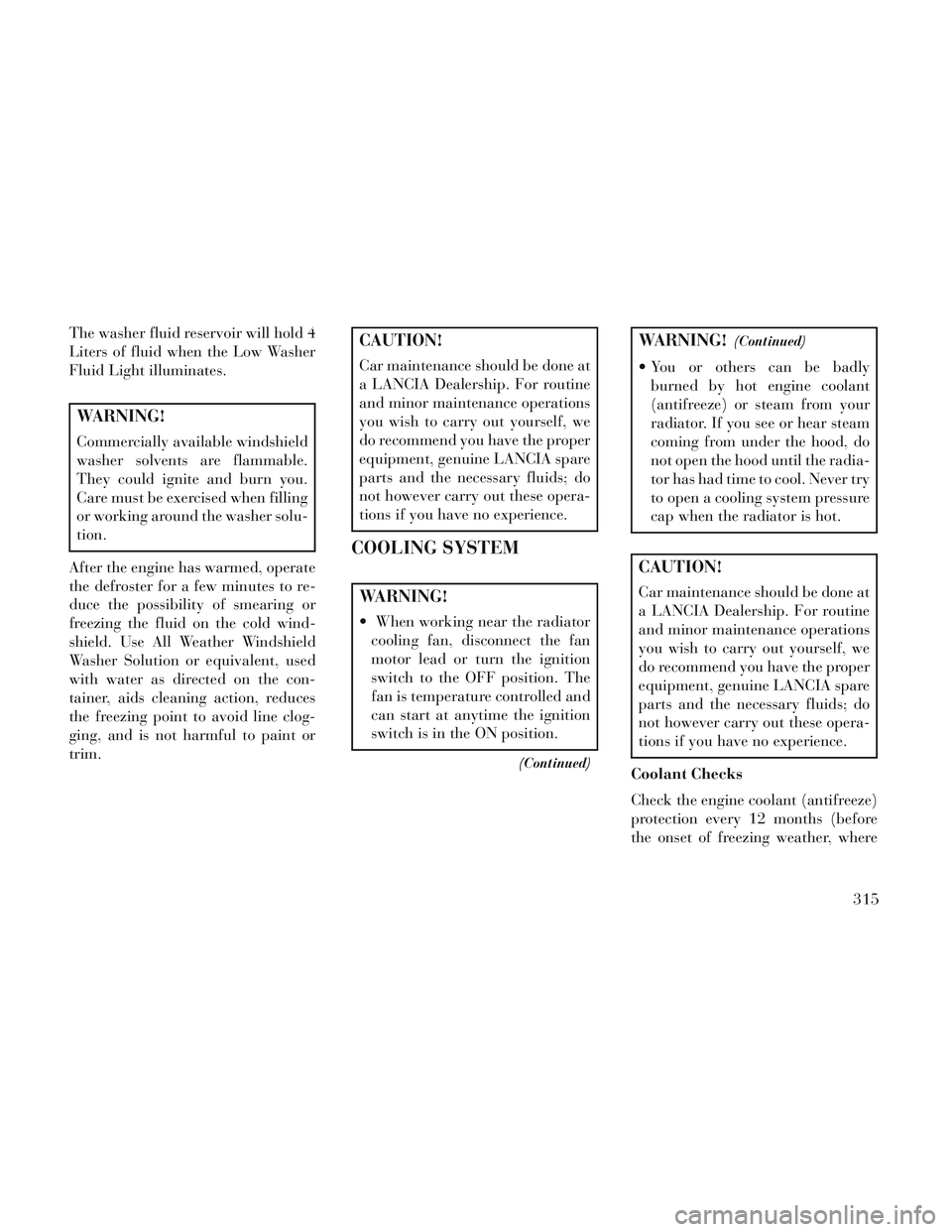
The washer fluid reservoir will hold 4
Liters of fluid when the Low Washer
Fluid Light illuminates.
WARNING!
Commercially available windshield
washer solvents are flammable.
They could ignite and burn you.
Care must be exercised when filling
or working around the washer solu-
tion.
After the engine has warmed, operate
the defroster for a few minutes to re-
duce the possibility of smearing or
freezing the fluid on the cold wind-
shield. Use All Weather Windshield
Washer Solution or equivalent, used
with water as directed on the con-
tainer, aids cleaning action, reduces
the freezing point to avoid line clog-
ging, and is not harmful to paint or
trim.
CAUTION!
Car maintenance should be done at
a LANCIA Dealership. For routine
and minor maintenance operations
you wish to carry out yourself, we
do recommend you have the proper
equipment, genuine LANCIA spare
parts and the necessary fluids; do
not however carry out these opera-
tions if you have no experience.
COOLING SYSTEM
WARNING!
When working near the radiator cooling fan, disconnect the fan
motor lead or turn the ignition
switch to the OFF position. The
fan is temperature controlled and
can start at anytime the ignition
switch is in the ON position.
(Continued)
WARNING!(Continued)
You or others can be badlyburned by hot engine coolant
(antifreeze) or steam from your
radiator. If you see or hear steam
coming from under the hood, do
not open the hood until the radia-
tor has had time to cool. Never try
to open a cooling system pressure
cap when the radiator is hot.
CAUTION!
Car maintenance should be done at
a LANCIA Dealership. For routine
and minor maintenance operations
you wish to carry out yourself, we
do recommend you have the proper
equipment, genuine LANCIA spare
parts and the necessary fluids; do
not however carry out these opera-
tions if you have no experience.
Coolant Checks
Check the engine coolant (antifreeze)
protection every 12 months (before
the onset of freezing weather, where
315
Page 322 of 364

applicable). If the engine coolant (an-
tifreeze) is dirty, the system should be
drained, flushed, and refilled with
fresh OAT coolant (conforming to
FIAT Classification 9.55523) only by
an authorized dealer. Check the front
of the A/C condenser for any accumu-
lation of bugs, leaves, etc. If dirty,
clean by gently spraying water from a
garden hose vertically down the face
of the condenser.
Check the coolant recovery bottle
tubing for brittle rubber, cracking ,
tears, cuts and tightness of the con-
nection at the bottle and radiator. In-
spect the entire system for leaks.
With the engine at normal operating
temperature (but not running), check
the cooling system pressure cap for
proper vacuum sealing by draining a
small amount of engine coolant (anti-
freeze) from the radiator drain cock.
If the cap is sealing properly, the en-
gine coolant (antifreeze) will begin to
drain from the coolant recovery
bottle. DO NOT REMOVE THE
COOLANT PRESSURE CAP WHEN
THE COOLING SYSTEM IS HOT.Cooling System – Drain, Flush,
And Refill
If the engine coolant (antifreeze) is
dirty or contains a considerable
amount of sediment, clean and flush
with a reliable cooling system cleaner.
Follow with a thorough rinsing to re-
move all deposits and chemicals.
Properly dispose of old engine coolant
(antifreeze).
Refer to the “Maintenance Schedule”
for the proper maintenance intervals.
Selection Of Coolant
Use only the manufacturer's recom-
mended engine coolant (antifreeze).
Refer to “Fluids, Lubricants and
Genuine Parts” in “Maintaining Your
Vehicle” for further information.CAUTION!
Mixing of engine coolant (anti-
freeze) other than specified en-
gine coolant (antifreeze), may re-
sult in engine damage and may
decrease corrosion protection. If a
non-specified engine coolant (an-
tifreeze) is introduced into the
cooling system in an emergency, it
should be replaced with the speci-
fied engine coolant (antifreeze) as
soon as possible.
Do not use plain water alone or alcohol-based engine coolant
(antifreeze) products. Do not use
additional rust inhibitors or anti-
rust products, as they may not be
compatible with the radiator en-
gine coolant (antifreeze) and may
plug the radiator.
This vehicle has not been de- signed for use with Propylene
Glycol based engine coolant (an-
tifreeze). Use of Propylene Glycol
based engine coolant (antifreeze)
is not recommended.
316
Page 323 of 364
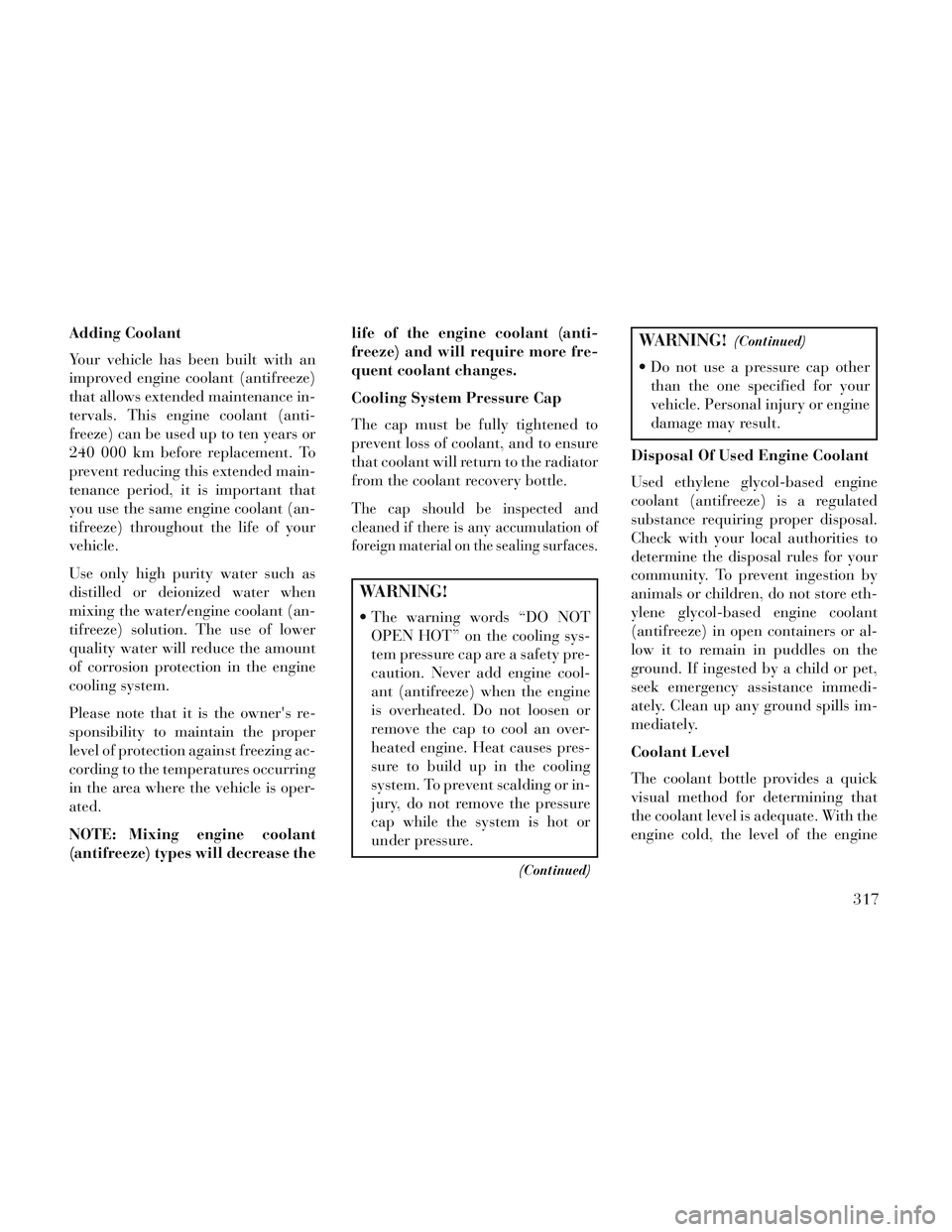
Adding Coolant
Your vehicle has been built with an
improved engine coolant (antifreeze)
that allows extended maintenance in-
tervals. This engine coolant (anti-
freeze) can be used up to ten years or
240 000 km before replacement. To
prevent reducing this extended main-
tenance period, it is important that
you use the same engine coolant (an-
tifreeze) throughout the life of your
vehicle.
Use only high purity water such as
distilled or deionized water when
mixing the water/engine coolant (an-
tifreeze) solution. The use of lower
quality water will reduce the amount
of corrosion protection in the engine
cooling system.
Please note that it is the owner's re-
sponsibility to maintain the proper
level of protection against freezing ac-
cording to the temperatures occurring
in the area where the vehicle is oper-
ated.
NOTE: Mixing engine coolant
(antifreeze) types will decrease thelife of the engine coolant (anti-
freeze) and will require more fre-
quent coolant changes.
Cooling System Pressure Cap
The cap must be fully tightened to
prevent loss of coolant, and to ensure
that coolant will return to the radiator
from the coolant recovery bottle.
The cap should be inspected and
cleaned if there is any accumulation of
foreign material on the sealing surfaces.
WARNING!
The warning words “DO NOT
OPEN HOT” on the cooling sys-
tem pressure cap are a safety pre-
caution. Never add engine cool-
ant (antifreeze) when the engine
is overheated. Do not loosen or
remove the cap to cool an over-
heated engine. Heat causes pres-
sure to build up in the cooling
system. To prevent scalding or in-
jury, do not remove the pressure
cap while the system is hot or
under pressure.
(Continued)
WARNING!(Continued)
Do not use a pressure cap otherthan the one specified for your
vehicle. Personal injury or engine
damage may result.
Disposal Of Used Engine Coolant
Used ethylene glycol-based engine
coolant (antifreeze) is a regulated
substance requiring proper disposal.
Check with your local authorities to
determine the disposal rules for your
community. To prevent ingestion by
animals or children, do not store eth-
ylene glycol-based engine coolant
(antifreeze) in open containers or al-
low it to remain in puddles on the
ground. If ingested by a child or pet,
seek emergency assistance immedi-
ately. Clean up any ground spills im-
mediately.
Coolant Level
The coolant bottle provides a quick
visual method for determining that
the coolant level is adequate. With the
engine cold, the level of the engine
317
Page 324 of 364
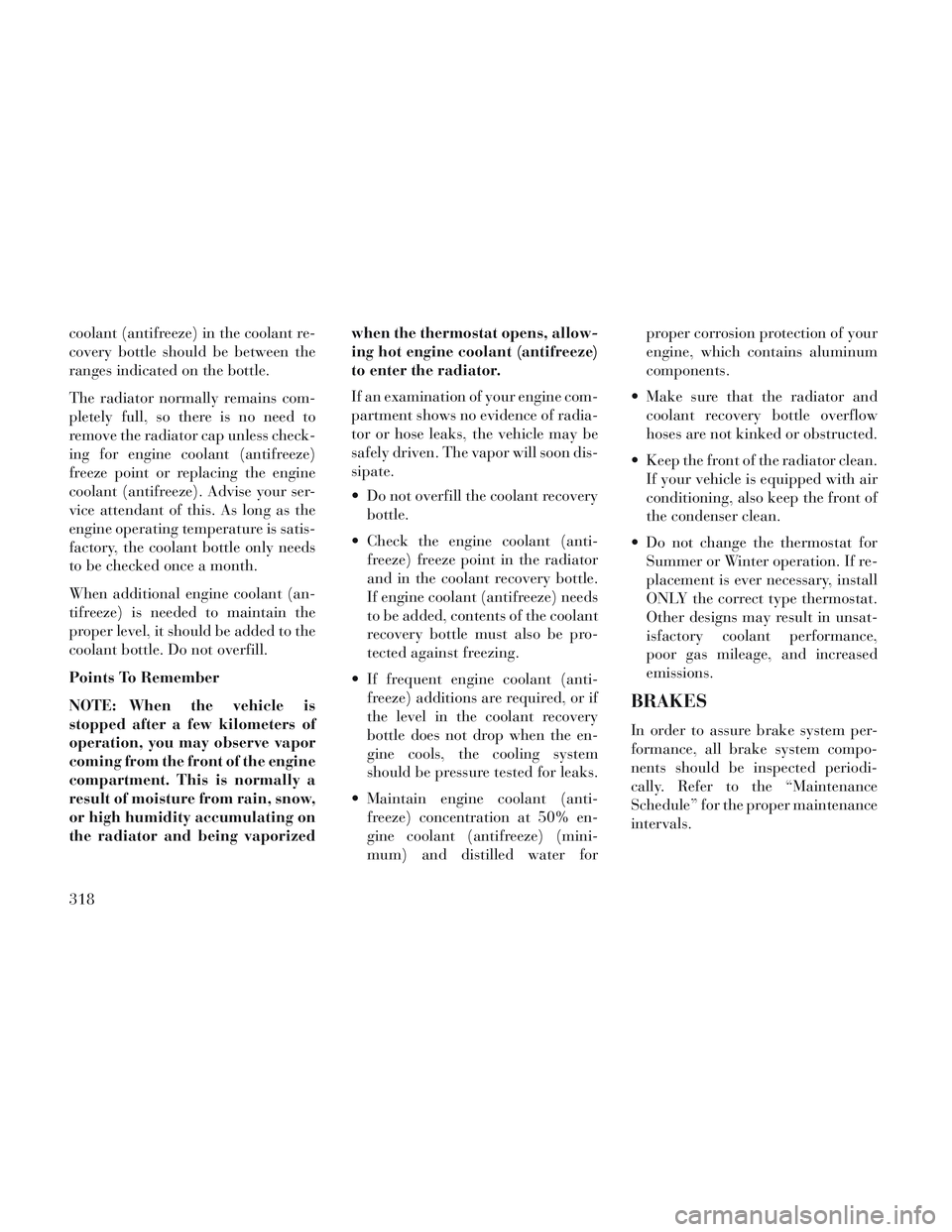
coolant (antifreeze) in the coolant re-
covery bottle should be between the
ranges indicated on the bottle.
The radiator normally remains com-
pletely full, so there is no need to
remove the radiator cap unless check-
ing for engine coolant (antifreeze)
freeze point or replacing the engine
coolant (antifreeze). Advise your ser-
vice attendant of this. As long as the
engine operating temperature is satis-
factory, the coolant bottle only needs
to be checked once a month.
When additional engine coolant (an-
tifreeze) is needed to maintain the
proper level, it should be added to the
coolant bottle. Do not overfill.
Points To Remember
NOTE: When the vehicle is
stopped after a few kilometers of
operation, you may observe vapor
coming from the front of the engine
compartment. This is normally a
result of moisture from rain, snow,
or high humidity accumulating on
the radiator and being vaporizedwhen the thermostat opens, allow-
ing hot engine coolant (antifreeze)
to enter the radiator.
If an examination of your engine com-
partment shows no evidence of radia-
tor or hose leaks, the vehicle may be
safely driven. The vapor will soon dis-
sipate.
Do not overfill the coolant recovery
bottle.
Check the engine coolant (anti- freeze) freeze point in the radiator
and in the coolant recovery bottle.
If engine coolant (antifreeze) needs
to be added, contents of the coolant
recovery bottle must also be pro-
tected against freezing.
If frequent engine coolant (anti- freeze) additions are required, or if
the level in the coolant recovery
bottle does not drop when the en-
gine cools, the cooling system
should be pressure tested for leaks.
Maintain engine coolant (anti- freeze) concentration at 50% en-
gine coolant (antifreeze) (mini-
mum) and distilled water for proper corrosion protection of your
engine, which contains aluminum
components.
Make sure that the radiator and coolant recovery bottle overflow
hoses are not kinked or obstructed.
Keep the front of the radiator clean. If your vehicle is equipped with air
conditioning, also keep the front of
the condenser clean.
Do not change the thermostat for Summer or Winter operation. If re-
placement is ever necessary, install
ONLY the correct type thermostat.
Other designs may result in unsat-
isfactory coolant performance,
poor gas mileage, and increased
emissions.
BRAKES
In order to assure brake system per-
formance, all brake system compo-
nents should be inspected periodi-
cally. Refer to the “Maintenance
Schedule” for the proper maintenance
intervals.
318